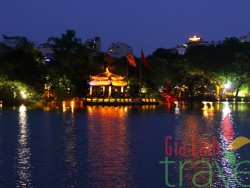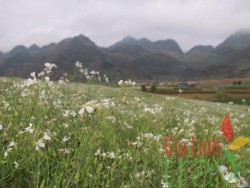Co To Island in summer
Weather in the North of Vietnam
Weather in the North of Vietnam


Hanoi in the fall

Spring in the North of Vietnam
The dry season
The dry season, from October to May, is divided into three periods. From October to November, it’s comfortable and dry. From December to February, it’s considerably cooler, and might sometimes be bitingly cold with persistent light drizzle, locally often known as ‘mua bui’ – ‘rain dust’. Skies are grey in late January and early February, however heat bright spells do occur. The average temperature is about 20°C however can fall to 6°C or 7°C at night. From March to Might, it is a lot warmer and drier, and may sometimes be quite hot.
The moist season
The rainy season is from June to September – the wettest months are July and August. Previously, violent tropical storms had been an everyday prevalence – indeed, some tourist guide books nonetheless warn against them. In actuality, there was a marked climate change lately – the final serious storm occurred in 1999. Spectacular thunderstorms are widespread, however will not be a lot of an issue in case you keep away from the deluge that comes with them.
| Hanoi’s weather | Jan | Feb | Mar | Apr | May | June | July | Aug | Sept | Oct | Nov | Dec |
| Mean high temperature (˚C) | 20 | 20 | 23 | 27 | 32 | 33 | 32 | 32 | 31 | 29 | 26 | 22 |
| Mean high temperature (˚F) | 69 | 69 | 74 | 81 | 89 | 91 | 90 | 90 | 88 | 84 | 78 | 72 |
| Mean low temperature (˚C) | 14 | 14 | 17 | 21 | 24 | 26 | 26 | 26 | 24 | 22 | 18 | 15 |
| Mean low temperature (˚F) | 57 | 58 | 63 | 69 | 75 | 78 | 78 | 78 | 76 | 71 | 65 | 59 |
| Rainfall in inches | 0.7 | 1.0 | 1.8 | 3.3 | 7.6 | 9.4 | 11.6 | 12.2 | 10.1 | 5.0 | 1.8 | 0.8 |
| Average percentage humidity | 73 | 76 | 80 | 79 | 73 | 75 | 76 | 79 | 76 | 72 | 71 | 71 |
Different weather in the northwest
In the northwest mountainous area, January and February are the coldest months. There are important quantities of fog at that time, and even an occasional flurry of snow. Sapa is without doubt one of the few locations in Viet Nam where hotels have fireplaces!
From March to early Might, and from September to December, the weather is superb but from June to August heavy rain makes climbing Mt. Fansipan and different peaks hazardous. Trekking is feasible, however heavy rain and thick mud makes it very strenuous and uncomfortable.
Unfortunately, weather information for the Sa Pa and Lau Chai are unavailable
The small town of Muong Bu, close to Son La, is about half-way between Hanoi and Dien Bien Phu in an area where the mountains are lower. It’s about 115km to the south of SA Pa as the crow flies but at an identical elevation. The weather patterns are similar.
| Muong Bu’s weather | Jan | Feb | Mar | Apr | May | June | July | Aug | Sept | Oct | Nov | Dec |
| Mean high temperature (˚C) | 11 | 12 | 18 | 21 | 22 | 22 | 23 | 22 | 22 | 18 | 17 | 13 |
| Mean high temperature (˚F) | 52 | 54 | 65 | 70 | 73 | 73 | 74 | 73 | 72 | 66 | 63 | 57 |
| Mean low temperature (˚C) | 5 | 6 | 11 | 13 | 16 | 17 | 17 | 17 | 16 | 13 | 10 | 7 |
| Mean low temperature (˚F) | 41 | 44 | 52 | 56 | 61 | 63 | 64 | 63 | 61 | 56 | 51 | 46 |
| Precipitation in inches | 1.6 | 2.8 | 4.7 | 7 | 14.6 | 14 | 18.9 | 18.9 | 12.6 | 7.5 | 4.7 | 1.6 |
| Number of rainy days | 3.1 | 4.8 | 5.5 | 5.3 | n/a | 17.4 | 20.3 | 20.3 | 14.5 | 10.7 | 8 | 3.1 |
Weather statistics aren’t available for Ha Long Bay. Nonetheless, the weather within the bay area is very similar to that of Hanoi, about the identical temperatures however barely less rain. The one significance is mild onshore breeze that makes the peak summer temperatures and humidity extra bearable.
Excessive weather
The north is subject to the occasional storm; however at this distance from the Equator, they’ve weakened and infrequently cause critical damage. Of extra concern are localized phenomena that can cause lack of life. For instance, though the weather could also be heat and sunny within the northern mountains, earlier heavy rain larger within the mountains can cause sudden flash flooding of the streams and rivers in the valleys.
To protect towards such accidents, we always work with the best local operators and guides, as they’ve detailed knowledge of the area, and particularly of the weather patterns. A skilled local guide is ready to anticipate such dangers and both use a contingency plan, or if necessary, abort the activity if there is any risk of danger.
The identical principle applies in Ha Long. Although Ha Long Bay is sheltered by its many islands, sometimes an abrupt localized squall can overturn even boats. We use only large licensed boats with full safety certificates and equipment together with ship-to-shore communication, crewed by people who know the bay inside out and never take risks.
